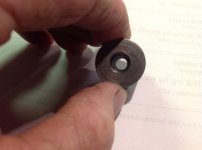Well, I tried it, and using the feel of the bolt handle touching the extraction cam seems to my inexperienced hand the more sensitive of the two possible ways to do this, the other being the feel of the handle closing, or rather falling. I got a falling handle quite a bit before I got to just feeling the root of the bolt handle make contact with the extractor cam. I sized a case, with a one piece Hornady FL die set to make sure that I was not feeling the case at all. The shoulder was bumped well out of the way. I tried the case by itself... absolutely no feel at all. I worked the Wilson die shortening the loaded length in small increments, and at the last was making adjustment of .001. When I made what I thought would be my final adjustment, I checked myself by seating the bullet .001 deeper and got nothing on the cam, and no mark on the bullet, this with the bullet likely textured with 0000, and looking at the marks with a low power, over the head binocular magnifier. Having been through this once, I would expect that I will gradually shorten up the time that it takes considerably. I was measuring the combined length of the stem and cap (non-micrometer die) each time. All this time in shooting, and I had never run across this method before. IMO it is the most precise method for finding touch that I can imagine. I will color the case and keep it in my PPC loading kit. Just out of curiosity, I resized the case, seated the bullet long, measured the tip to head dimension, chambered it, and remeasured it. It had shortened, the neck tension was .002 and the difference between the barest touch and jam was .020. The barrel is a rechambered Rock Creek with 5R rifling. The rifle has no ejector. For the last two checks I put the rim under the extractor and inserted the combined dummy round and bolt into the action, feeling for the point where I could start to close the bolt, and just after starting rotation, keeping rearward pressure on the handle as I closed the bolt. If I were working with spring plunger ejector, I would have to do something different. I might sacrifice a case, cut away one section of the head to make clearance for the ejector, and load the case on the bolt face every time that I made a measurement. Understand, I would never bother with all of this for any field application, having gotten perfectly satisfactory results using less demanding methods, but for those situations where I want to leave no stone un-turned, this would be one of those stones.


